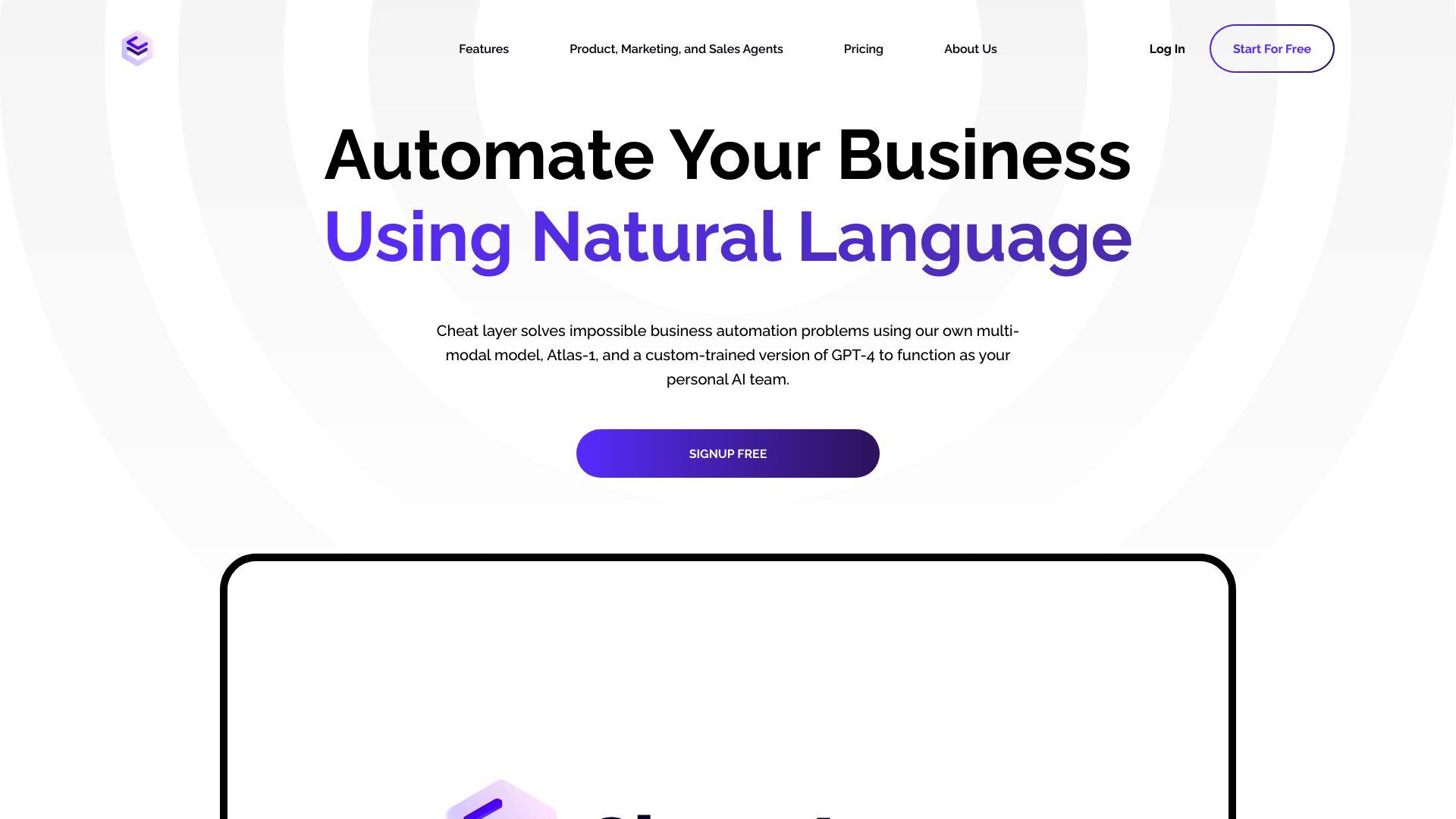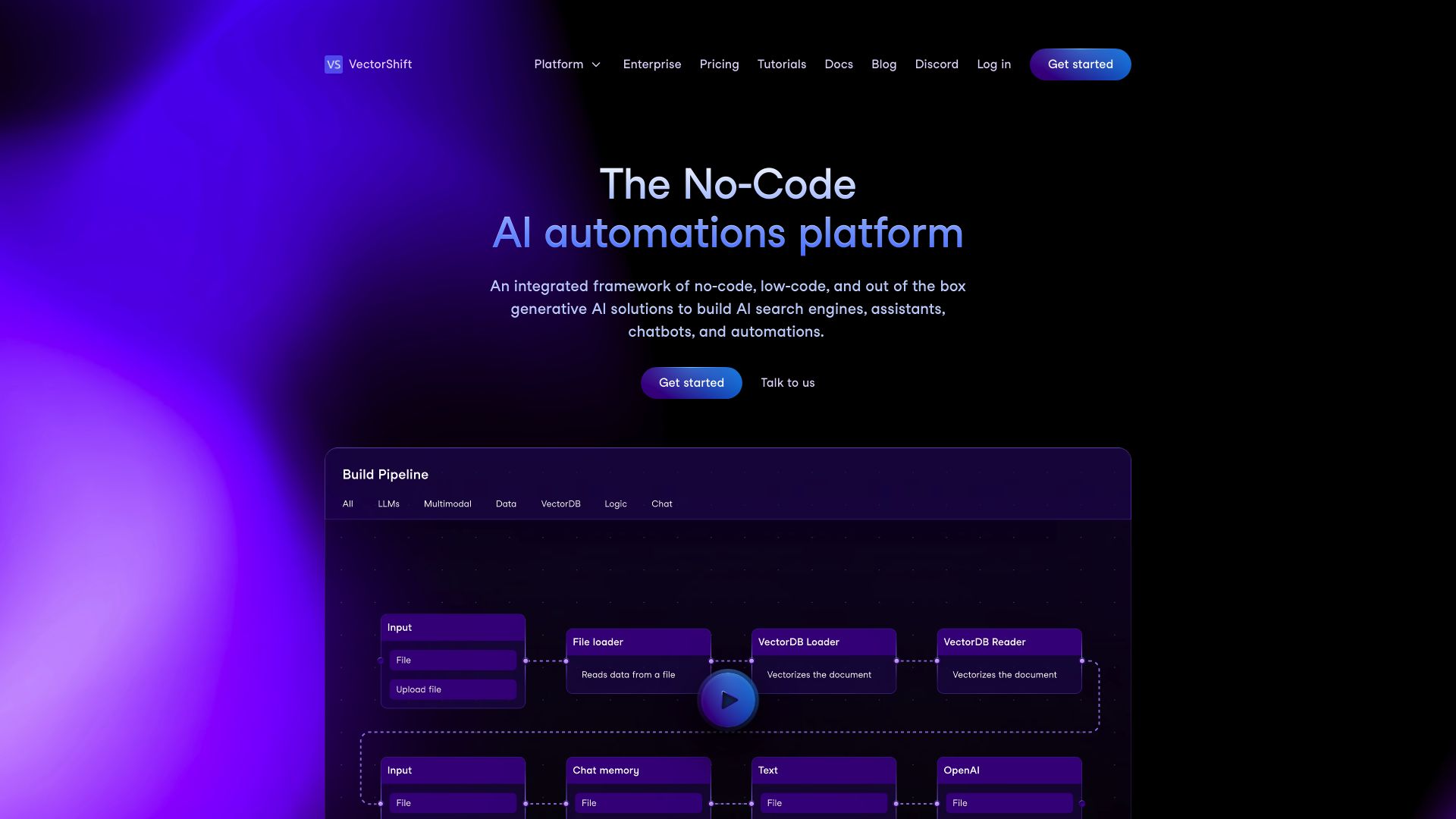Cheat Layer vs. VectorShift: AI Automation Platforms Compared
AI-powered automation platforms revolutionize business processes, empowering organizations to streamline operations and unlock new efficiencies. This comparison delves into three leading solutions: Cheat Layer vs. VectorShift, and SmythOS. We’ll explore their unique approaches to AI integration, examining key features, strengths, and potential limitations.
Whether you’re a developer seeking powerful APIs, a business leader focused on scalability and security, or a non-technical user looking for intuitive tools, this analysis will help you navigate the landscape of AI automation platforms. Discover how each solution tackles complex workflows, offers no-code options, and enables seamless integrations – ultimately guiding you towards the platform best suited to transform your business with the power of AI.
Cheat Layer Overview
Cheat Layer revolutionizes business automation by harnessing the power of AI. The platform leverages a custom-trained version of GPT-4 and their multi-modal model Atlas-1 to solve complex automation challenges using natural language. This approach makes advanced automation accessible even to non-technical users, democratizing AI-driven business solutions.
At the core of Cheat Layer’s offering is the Project Atlas Framework. This innovative system allows users to generate automations of unlimited complexity through simple conversational interactions. By communicating with the system as if speaking to an engineer, users can create comprehensive end-to-end solutions without extensive technical knowledge.
Cheat Layer revolutionizes business automation by harnessing the power of AI… This approach makes advanced automation accessible even to non-technical users, democratizing AI-driven business solutions.
Cheat Layer stands out with its Semantic Targets feature, ensuring robust and future-proof automations. This technology uses natural language to define automation targets, maintaining functionality even when services update their designs. The platform also offers 1-Click Cloud Agents, enabling users to deploy pre-built marketing and sales agents directly from mobile devices. These agents automate processes such as content generation, A/B testing, and lead generation with minimal setup requirements.


The platform’s Live Mode allows iterative building and deployment of products like apps and landing pages, providing real-time feedback to ensure outputs match intended goals. For those without coding expertise, Cheat Layer provides a no-code interface with a drag-and-drop editor, simplifying the creation of complex automations. Additionally, the platform offers white-label solutions, enabling agencies to create and resell custom automation solutions as branded Chrome extensions.
Cheat Layer’s vision… aims to level the playing field in business technology, empowering small businesses to compete with larger firms by providing powerful, accessible, and cost-effective automation tools.
Cheat Layer’s vision extends beyond mere automation tools. The company aims to level the playing field in business technology, empowering small businesses to compete with larger firms by providing powerful, accessible, and cost-effective automation tools. By removing barriers to business creation and operation, Cheat Layer fosters an environment where quality service and personal relationships drive success, rather than technological advantages traditionally held by larger corporations.
VectorShift Overview
VectorShift offers a robust platform for designing, prototyping, and managing generative AI workflows and automations. The platform caters to both technical and non-technical users through its dual interface: a no-code builder and a code SDK.


VectorShift’s platform supports a wide range of applications, including chatbots, search functionalities, automations, and content creation. Users can automate workflows end-to-end, schedule tasks, and trigger actions based on predefined events. The platform integrates seamlessly with various data sources like Google Drive, Slack, and Airtable, enabling centralized data management and live-syncing across applications.
VectorShift’s platform supports a wide range of applications, including chatbots, search functionalities, automations, and content creation. Users can automate workflows end-to-end, schedule tasks, and trigger actions…
At the core of VectorShift’s offering is the pipeline dashboard, allowing users to create AI workflows from scratch or using templates. This feature streamlines the deployment process, making it efficient for users of varying technical backgrounds. The platform also boasts a robust knowledge base that centralizes data and performs semantic searches, enhancing the AI’s ability to provide accurate and relevant information.
VectorShift provides flexibility in deployment options, allowing pipelines to be deployed as chatbots, automations, or search functions. Users can customize and export their solutions in various formats, including URL, iFrame, WhatsApp/SMS bots, API endpoints, and Slack App bots. This versatility enables businesses to implement AI solutions tailored to their specific needs and preferred communication channels.
VectorShift provides flexibility in deployment options, allowing pipelines to be deployed as chatbots, automations, or search functions. Users can customize and export their solutions in various formats…
While VectorShift offers a comprehensive suite of features, users should consider potential challenges such as integration complexities with legacy systems and the learning curve associated with maximizing the platform’s capabilities. As with any AI platform, careful consideration of data privacy and security measures is essential, especially when handling sensitive information.
Feature Comparison
SmythOS and VectorShift both offer robust platforms for AI agent development, but key differences emerge in their core components and security features. SmythOS provides a more comprehensive suite of tools for agent creation and management. Its visual builder and no-code editor surpass VectorShift’s offerings, making AI development accessible to users of all skill levels. SmythOS also excels in memory and context handling, allowing agents to maintain more nuanced, context-aware interactions.
In terms of security, SmythOS takes the lead with its advanced constrained alignment features. This ensures AI behaviors align closely with organizational goals and ethical guidelines—a critical consideration for enterprise deployments. While both platforms offer data encryption, SmythOS’s implementation appears more robust, providing an additional layer of protection for sensitive information.
VectorShift falls short in several areas where SmythOS shines. Notably, VectorShift lacks SmythOS’s advanced debugging tools, which are crucial for refining agent performance. Additionally, SmythOS’s superior multi-agent collaboration capabilities enable more complex, coordinated AI solutions that VectorShift struggles to match. These gaps highlight SmythOS’s edge in delivering a more complete, enterprise-ready AI development ecosystem.
Feature Comparison Table
| Cheat Layer | VectorShift | SmythOS | |
|---|---|---|---|
| CORE FEATURES | |||
| Hosted Agents (Dev, Production) | ✅ | ❌ | ✅ |
| Environments (Dev, Production) | ✅ | ❌ | ✅ |
| Autonomous Agents | ✅ | ❌ | ✅ |
| Explainability & Transparency | ✅ | ❌ | ✅ |
| Debug Tools | ✅ | ❌ | ✅ |
| Multi-Agent Collaboration | ✅ | ❌ | ✅ |
| Audit Logs for Analytics | ✅ | ❌ | ✅ |
| SECURITY | |||
| Constrained Alignment | ✅ | ❌ | ✅ |
| Data Encryption | ✅ | ❌ | ✅ |
| IP Control | ❌ | ❌ | ✅ |
| COMPONENTS | |||
| Huggingface AIs | ❌ | ❌ | ✅ |
| Zapier APIs | ✅ | ❌ | ✅ |
| Classifiers | ✅ | ❌ | ✅ |
| Data Lakes | ❌ | ❌ | ✅ |
| DEPLOYMENT OPTIONS (EMBODIMENTS) | |||
| Staging Domains | ✅ | ❌ | ✅ |
| Production Domains | ✅ | ❌ | ✅ |
| Deploy as GPT | ✅ | ❌ | ✅ |
| DATA LAKE SUPPORT | |||
| Hosted Vector Database | ❌ | ✅ | ✅ |
| Sitemap Crawler | ✅ | ❌ | ✅ |
Best Alternative to Cheat Layer and VectorShift
SmythOS stands out as the superior alternative to Cheat Layer and VectorShift for AI agent development and deployment. Our platform offers unparalleled versatility and power, making it the ideal choice for businesses and developers seeking to harness the full potential of AI automation.
We’ve designed SmythOS with a focus on ease of use without sacrificing advanced capabilities. Our visual builder and no-code editor surpass the offerings of both Cheat Layer and VectorShift, allowing users of all skill levels to create sophisticated AI agents quickly. This accessibility doesn’t come at the cost of functionality—SmythOS provides a rich set of features that cater to both beginners and experienced developers.
SmythOS excels in multi-agent collaboration, enabling the creation of complex, coordinated AI solutions. This feature sets us apart, allowing businesses to tackle intricate problems that require multiple AI agents working in tandem.
Unlike our competitors, SmythOS excels in multi-agent collaboration, enabling the creation of complex, coordinated AI solutions. This feature sets us apart, allowing businesses to tackle intricate problems that require multiple AI agents working in tandem. Our platform also boasts superior debugging tools, crucial for refining agent performance and ensuring optimal functionality in real-world applications.
Security is a top priority in SmythOS. We implement advanced constrained alignment features, ensuring AI behaviors align closely with organizational goals and ethical guidelines. This level of control is essential for enterprise deployments and sets us apart from both Cheat Layer and VectorShift. Additionally, our robust data encryption provides an extra layer of protection for sensitive information, addressing critical security concerns in AI implementation.
SmythOS offers unmatched flexibility in deployment options. Whether you need to deploy as an API, a website chatbot, or integrate with popular platforms like GPT, our system accommodates a wide range of use cases. This versatility, combined with our scalable infrastructure, makes SmythOS the ideal choice for businesses looking to grow and adapt their AI solutions over time.
Conclusion
Cheat Layer, VectorShift, and SmythOS each offer unique approaches to AI-driven automation and workflow management. Cheat Layer excels in natural language-based automation, making complex processes accessible to non-technical users. VectorShift provides a versatile platform for creating AI workflows with both no-code and code options. However, SmythOS emerges as the superior choice, offering a comprehensive suite of features that surpass its competitors.
SmythOS stands out with its intuitive drag-and-drop interface, extensive integration ecosystem, and advanced multi-agent collaboration capabilities. These features, combined with robust security measures like constrained alignment and data encryption, make SmythOS the ideal solution for businesses seeking to harness AI’s full potential. The platform’s ability to deploy agents across various environments and its support for a wide range of AI models further cement its position as the most versatile and powerful option.
While Cheat Layer and VectorShift have their strengths, SmythOS offers a more complete package for enterprises looking to integrate AI into their operations seamlessly. Its advanced debugging tools, scalability, and focus on user-friendly design make it accessible to both technical and non-technical users alike. For businesses aiming to stay at the forefront of AI technology while maintaining security and ease of use, SmythOS is the clear choice.
To experience the transformative power of SmythOS for yourself, explore our diverse range of AI-powered agent templates or create a free SmythOS account today. Unlock the future of AI-driven productivity and innovation with SmythOS – where creating intelligent automation is 99% faster and infinitely more accessible.
Last updated:
Disclaimer: The information presented in this article is for general informational purposes only and is provided as is. While we strive to keep the content up-to-date and accurate, we make no representations or warranties of any kind, express or implied, about the completeness, accuracy, reliability, suitability, or availability of the information contained in this article.
Any reliance you place on such information is strictly at your own risk. We reserve the right to make additions, deletions, or modifications to the contents of this article at any time without prior notice.
In no event will we be liable for any loss or damage including without limitation, indirect or consequential loss or damage, or any loss or damage whatsoever arising from loss of data, profits, or any other loss not specified herein arising out of, or in connection with, the use of this article.
Despite our best efforts, this article may contain oversights, errors, or omissions. If you notice any inaccuracies or have concerns about the content, please report them through our content feedback form. Your input helps us maintain the quality and reliability of our information.
